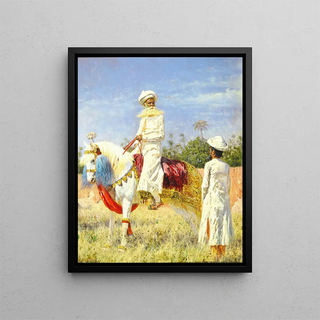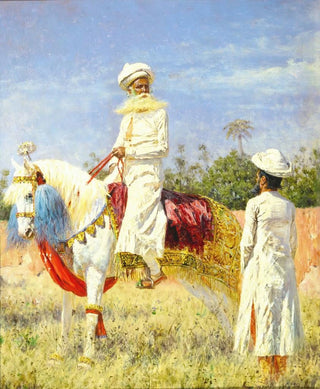Art print | Cavalier à Jaipur - Vasily Vereshchagin


View from behind

Frame (optional)
In the fascinating world of art, some works transcend the simple frame to tell vibrant and immersive stories. "Cavalier à Jaipur" by Vasily Vereshchagin is one of those creations that, through its evocative power, transports the viewer to the heart of a journey through time and space. This piece, which captures the very essence of India at the end of the 19th century, immerses us in a universe where culture, tradition, and humanity meet in a ballet of colors and shapes. The art print of this iconic work allows us to understand not only the artist's technique but also the unique atmosphere emanating from each brushstroke.
Style and uniqueness of the work
Vereshchagin's style is undeniably marked by a realistic approach and a keen sense of detail. In "Cavalier à Jaipur," the viewer is immediately struck by the richness of textures and the depth of colors. The vibrant shades of traditional clothing, the dynamic movement of the rider, and the majestic landscape in the background intertwine to create a harmonious composition. This painting is much more than a simple depiction of a rider; it evokes an atmosphere, a culture, and a way of life, while celebrating the beauty of everyday life. Vereshchagin, through his talent, manages to capture the soul of India, making each element of the work meaningful and emotionally charged.
The artist and his influence
Vasily Vereshchagin, born in 1842, was a Russian artist whose career was marked by a quest for truth and a passion for representing cultural realities. An unwavering traveler, he drew inspiration from his explorations around the world, particularly in Asia. His commitment to depicting authentic scenes, far from idealizations, made him a pioneer in the field of artistic realism. Vereshchagin does not merely paint scenes of war or exotic landscapes; he seeks to convey a human experience, to make the voices of the peoples he encounters resonate. His influence on modern art is undeniable, and "Cavalier à Jaipur" is a perfect example, because

Matte finish

View from behind

Frame (optional)
In the fascinating world of art, some works transcend the simple frame to tell vibrant and immersive stories. "Cavalier à Jaipur" by Vasily Vereshchagin is one of those creations that, through its evocative power, transports the viewer to the heart of a journey through time and space. This piece, which captures the very essence of India at the end of the 19th century, immerses us in a universe where culture, tradition, and humanity meet in a ballet of colors and shapes. The art print of this iconic work allows us to understand not only the artist's technique but also the unique atmosphere emanating from each brushstroke.
Style and uniqueness of the work
Vereshchagin's style is undeniably marked by a realistic approach and a keen sense of detail. In "Cavalier à Jaipur," the viewer is immediately struck by the richness of textures and the depth of colors. The vibrant shades of traditional clothing, the dynamic movement of the rider, and the majestic landscape in the background intertwine to create a harmonious composition. This painting is much more than a simple depiction of a rider; it evokes an atmosphere, a culture, and a way of life, while celebrating the beauty of everyday life. Vereshchagin, through his talent, manages to capture the soul of India, making each element of the work meaningful and emotionally charged.
The artist and his influence
Vasily Vereshchagin, born in 1842, was a Russian artist whose career was marked by a quest for truth and a passion for representing cultural realities. An unwavering traveler, he drew inspiration from his explorations around the world, particularly in Asia. His commitment to depicting authentic scenes, far from idealizations, made him a pioneer in the field of artistic realism. Vereshchagin does not merely paint scenes of war or exotic landscapes; he seeks to convey a human experience, to make the voices of the peoples he encounters resonate. His influence on modern art is undeniable, and "Cavalier à Jaipur" is a perfect example, because






